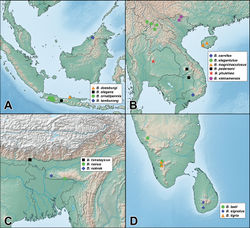Bolitogyrus tigris
| Notice: | This page is derived from the original publication listed below, whose author(s) should always be credited. Further contributors may edit and improve the content of this page and, consequently, need to be credited as well (see page history). Any assessment of factual correctness requires a careful review of the original article as well as of subsequent contributions.
If you are uncertain whether your planned contribution is correct or not, we suggest that you use the associated discussion page instead of editing the page directly. This page should be cited as follows (rationale):
Citation formats to copy and paste
BibTeX: @article{Brunke2017ZooKeys, RIS/ Endnote: TY - JOUR Wikipedia/ Citizendium: <ref name="Brunke2017ZooKeys">{{Citation See also the citation download page at the journal. |
Ordo: Coleoptera
Familia: Staphylinidae
Genus: Bolitogyrus
Name
Bolitogyrus tigris Brunke sp. n. – Wikispecies link – ZooBank link – Pensoft Profile
Type locality
10 km SW Munnar, Idukki District, Kerala, India.
Type material
Holotype (♂, NMW): S. INDIEN, Kerala, Cardamom hills, 1000m, 10km SW Munnar Vattiar [=Vattiyar?] (8) [printed] / 77°01'E 10°02'N, 5–17.12.1993, leg. Boukal & Kejval [printed] / AJB0000394 [identifier label] / HOLOTYPE Bolitogyrus tigris Brunke, des. A. Brunke 2017 [red label].
Paratype (♀, BMNH): India: Tamil Nadu: Coimbatore, Valparai, 1000 m, 15.X.1937, P.S. Nathan, AJB0000503.
Diagnosis
Bolitogyrus tigris is easily recognized by a combination of the minutely expanded pronotal margin (Fig. 4G), orange head, the bicolored abdominal tergites IV-V, and orange and black marked elytra (Fig. 1I).
Description
Measurements ♂ (n = 1): HW/HL 1.41; PW/PL 1.25; EW/ EL 1.17; ESut/PL 0.85; PW/HW 0.98; forebody length 6.0 mm.
Measurements
♀ (n = 1). HW/HL 1.28; PW/PL 1.22; EW/ EL 1.18; ESut/PL 0.83; PW/HW 1.0; forebody length 6.3 mm.
Coloration: body orange to reddish-orange (darkened paratype); head orange with central darkened area larger in female; disc of pronotum orange with central darkened area, a pair of dark spots laterally, a darkened areas along apex and base; elytra orange to reddish-orange (darkened paratype), with darkened area around scutellum; abdominal tergite III mostly dark with lateroapical areas orange, IV-V orange, dark basally and in narrow median stripe, VI entirely dark on disc, VII-VIII orange; antennomeres 1-5 brownish orange, 6-10 dark brown, 11 slightly paler than previous, lighter brown;
palpi brownish orange; legs brownish orange, with dorsal and lateral surfaces of mid and hind femur darkened, outer faces of tibia darker.
Head distinctly transverse; dorsal surface with moderately dense, clearly separated asetose punctures, frons with only scattered punctures. Antennomeres 8-10 transverse and asymmetrical.
Pronotum distinctly transverse, about as wide as head, convex and with shallow micropunctures scattered on disc, becoming more distinct on anterior angles. Elytra slightly transverse, suture slightly shorter than pronotum at middle; disc of elytron with slightly raised yellow v-shaped marking.
Abdomen with disc of tergites III-V distinctly impunctate; sternites III-IV with basal line distinctly projected posteriad at middle.
Median lobe in lateral view with apical portion projected ventrad, apex deflexed dorsad, with pair of basal teeth at level of apical fourth (Fig. 12L); median lobe in parameral view slightly dilated to apical fourth, spoon-shaped (Fig. 12K); paramere distinctly shorter than median lobe, distinctly bilobed, each lobe with pointed apex, constricted just basad of v-shaped median emargination (Fig. 12M); peg setae of each lobe arranged in marginal group and medial group, groups joined basally to form a ring (Fig. 12M); male sternite VIII with extremely shallow emargination and triangular glabrous area medially; male sternite IX moderately expanded at midlength, with distinct emargination.
Female with tergite VIII entire in single specimen studied, tergite X elongate triangular, with acute apex, raised disc of similar shape with broad median depression.
Distribution
Figure 20D. Known only from the Cardamom Hills in the Western Ghats of India.
Bionomics
Bolitogyrus tigris has been collected at 1000 m during October and December.
Etymology
This taxon shares its specific epithet with the Bengal Tiger (Panthera tigris tigris (L.)) in recognition of its orange and black appearance, shared distribution, and India’s network of preserved forest habitats in the Anaimalai, Palni and Cardamom Hills regions of the Western Ghats. Habitat-focused conservation preserves populations of popular megafauna but also predaceous beetles like Bolitogyrus tigris, a ‘tiger’ in its own right
Comments
Bolitogyrus tigris is easily recognized by coloration alone.
Original Description
- Brunke, A; 2017: A revision of the Oriental species of Bolitogyrus Chevrolat (Coleoptera, Staphylinidae, Staphylininae) ZooKeys, (664): 1-97. doi
Images
|
Other References
- ↑ Cai Y, Zhao Z, Zhou H (2015) Taxonomy of the genus Bolitogyrus Chevrolat (Coleoptera: Staphylinidae: Staphylinini: Quediina) from China with description of seven new species. Zootaxa 3955: 451–486. https://doi.org/10.11646/zootaxa.3955.4.1


![Figure 12. Bolitogyrus magnimaculosus Cai et al. (A–C), B. nokrek Brunke (D–G), B. lasti Rougemont (H–J) and B. tigris Brunke (K–M). Aedeagus in parameral view (H, K), median lobe in parameral view (A, D), median lobe in lateral view (B, E, I, L), peg setae of paramere (C, F, J, M), paramere in lateral view (G). Figures A–C modified from Cai et al. (2015)[1]. Scale bars: 0.5 mm.](https://species-id.net/o/thumb.php?f=Zookeys-664-001-g012.jpg&width=221)
